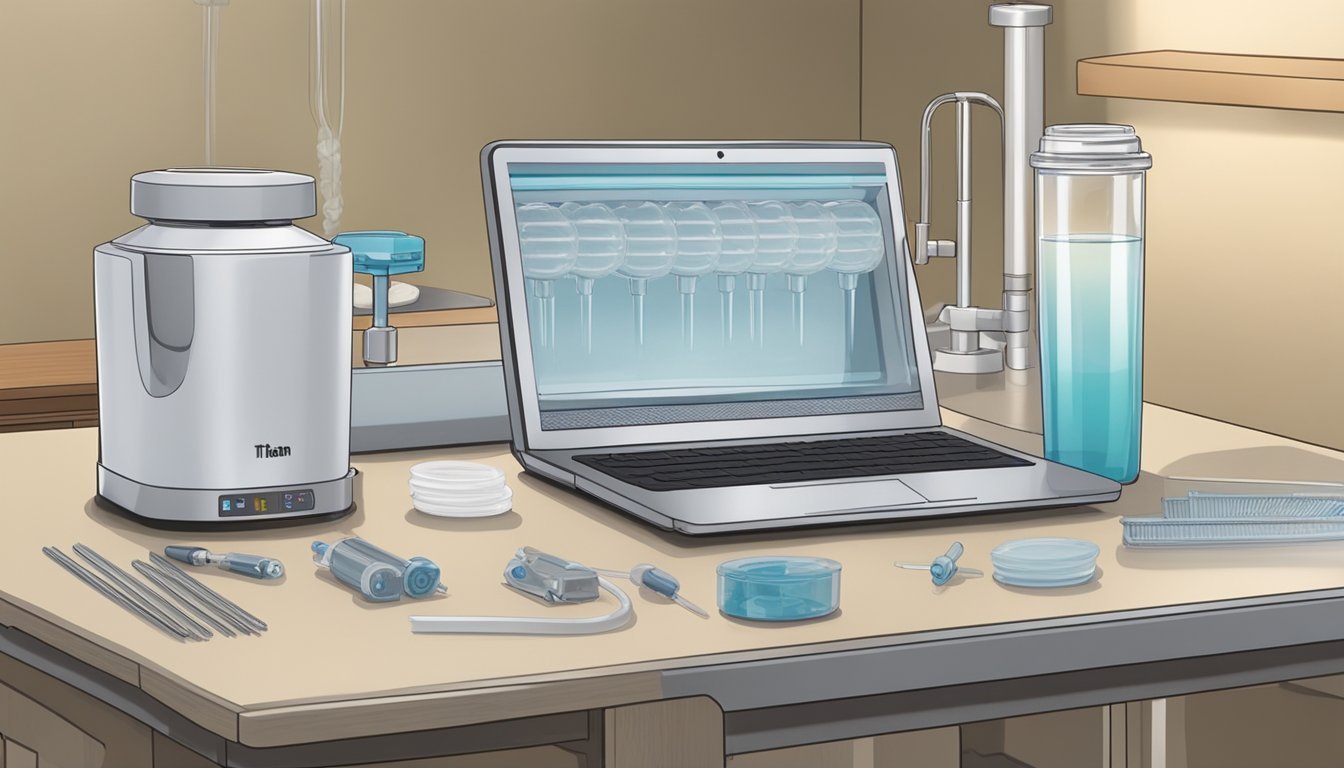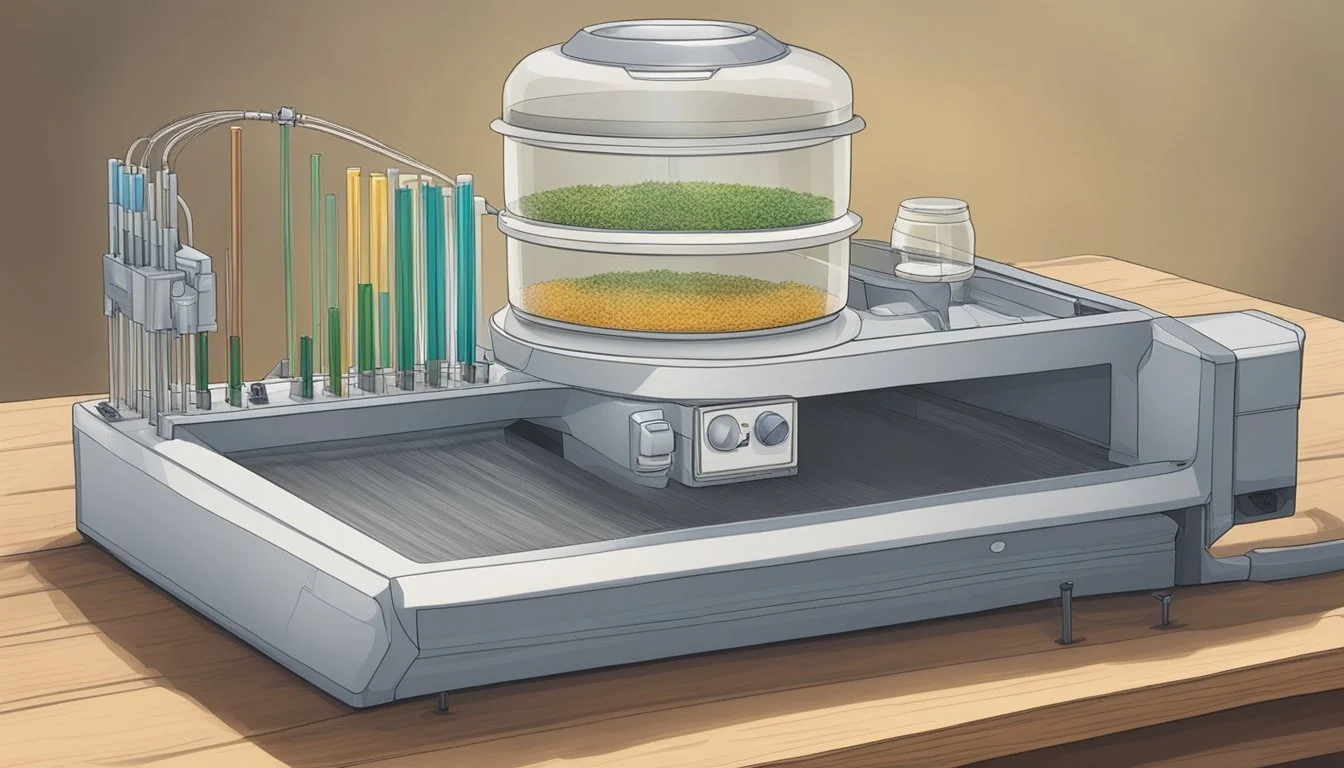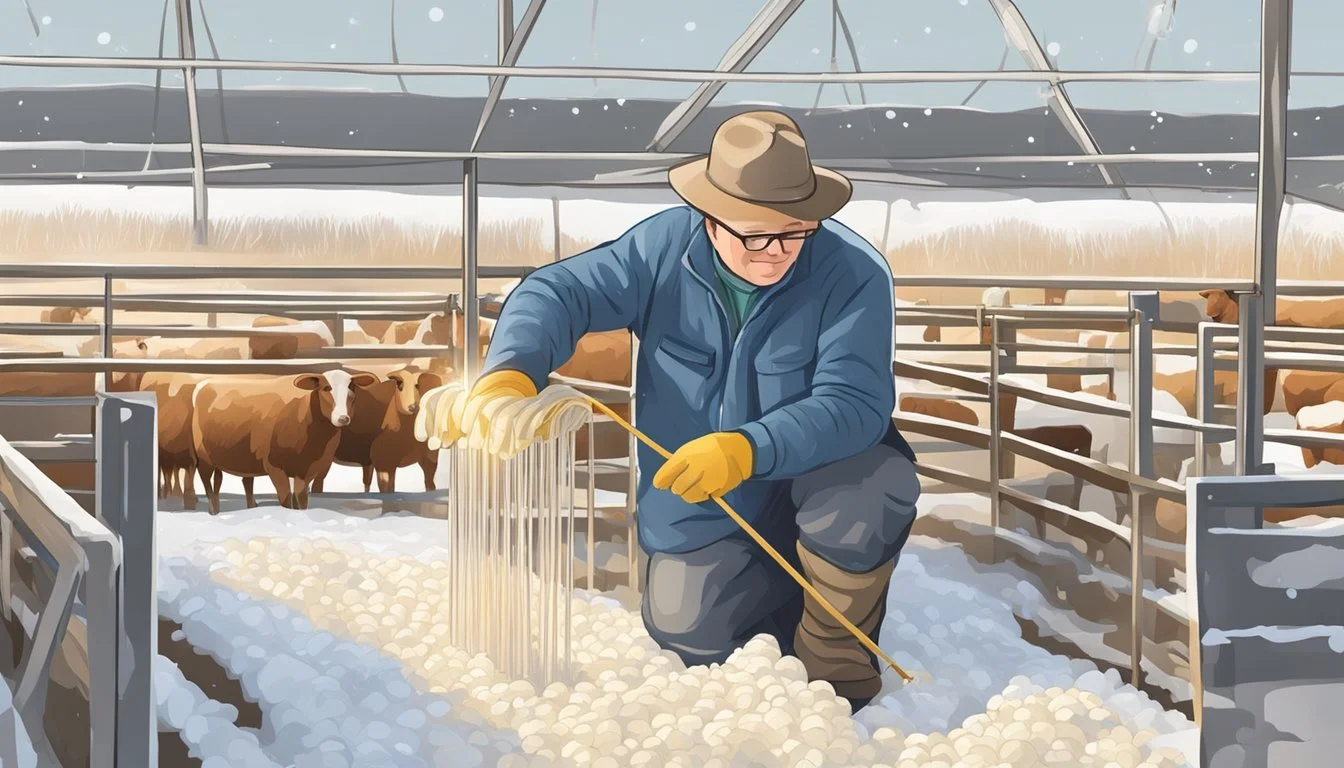How to Use an Animal AI Thaw Unit
Efficient Semen Straw Preparation for Homesteaders
Artificial insemination (AI) is a widely practiced technique in livestock breeding that allows homesteaders to introduce new genetics into their herds without the need for live animals to be present. This method involves the use of semen straws, which are small tubes containing frozen semen from a selected sire. These straws are essential to the AI process and must be handled with care to maintain the viability of the sperm. Thawing semen straws correctly is a critical step in AI because sperm are highly sensitive to temperature changes.
The process begins with a thaw unit, which is designed to bring semen straws up to a temperature that is suitable for insemination without damaging the sperm. The unit typically maintains water at a constant temperature, usually between 95-98 degrees Fahrenheit. The reliability of the thawing device is crucial as it ensures the semen reaches the correct temperature quickly and uniformly. Thawing time is generally brief, often just 30 to 60 seconds, but precise timing is critical for success.
When preparing for artificial insemination on a homestead, it is essential to keep the process as hygienic as possible to prevent introducing any contaminants. Equipment such as the AI gun, non-spermicidal lubricant, and the straw cutter must also be warmed and ready for use to avoid shocking the sperm with a sudden temperature change. The whole process, from thawing the semen to depositing it into the uterus, must be done efficiently and with precision to ensure the highest possible conception rates.
Understanding the Basics of Animal AI
Before delving into the technical aspects of using an animal AI thaw unit, it is important to grasp the core concepts of artificial insemination (AI). This includes understanding its significance in livestock breeding, the role of genetic selection, and the intricacies of fertility and reproductive health.
Artificial Insemination and Its Significance
Artificial insemination is a technique where semen is collected from a male animal and then manually inserted into the female reproductive tract. This method is notable for its role in enhancing reproductive performance on homesteads and farms. AI allows for the precise timing of insemination to coincide with the peak fertility of the female, which is crucial for optimal conception rates.
Significant advantages of AI include:
Improved Genetics: Selecting high-quality sires based on Expected Progeny Differences (EPDs) allows for the intentional breeding of livestock with superior traits.
Disease Control: AI reduces the risk of transmitting sexually transmitted diseases between animals.
Safety: Minimizes the risk of injury to both animals and handlers that can occur during natural mating.
Genetic Selection in Livestock
Genetic selection in livestock through AI is pivotal for herd improvement and increased productivity. It provides the opportunity for homesteaders to incorporate desirable genetic traits from a broader pool of sires, which may not be accessible otherwise. Sire selection is based on analyzing EPDs, which predict how future progeny of the sire are expected to perform relative to specific traits such as growth rate, milk production, and meat quality.
Factors to consider when selecting a sire:
EPDs: Breeders assess these values for comprehensive evaluation of the sire's genetic potential.
Breed: Compatibility with the current livestock's breed characteristics and production goals.
Trait Emphasis: Depending on the production aim (e.g., meat, milk, wool), traits are prioritized accordingly.
Fertility and Reproductive Tract Considerations
The female's fertility and the health of her reproductive tract are critical for the success of AI. Breeders must monitor the estrous cycle and detect the optimal time for insemination, as timing is a key factor in achieving high conception rates. Additionally, understanding the anatomy and physiology of the reproductive tract permits the proper handling of semen straws with the AI thaw unit and ensures that the process of insemination does not damage the tract or compromise the semen's viability.
Key factors for optimum fertility:
Estrous Cycle: Recognizing signs of heat ensures insemination is performed at the most fertile moment.
Reproductive Health: Regular check-ups and management practices reduce fertility issues.
Handling Semen: Proper thawing and preparation of semen affect spermatozoa quality and insemination success.
By integrating these fundamental concepts into their AI strategy, homesteaders can maximize their chances of successful livestock breeding outcomes.
Preparing the Thaw Unit and Semen Straws
To ensure the success of artificial insemination procedures on a homestead, it is crucial to follow a meticulous process for preparing the thaw unit and semen straws. Proper handling and temperature control are key to preserving semen quality throughout the thawing procedure.
Components of a Thaw Unit
A thaw unit typically consists of a water bath with a heating mechanism to maintain a stable temperature. It includes a thermometer for accurate temperature readings and may also be equipped with a timer to monitor thawing duration. Components should be clean and free from contaminants that could affect semen quality.
Setting Up the Thaw Unit
To set up the thaw unit, fill it with water and activate the heater to bring the water to the recommended temperature, usually around 95-98 degrees Fahrenheit (approximately 35-37 degrees Celsius). Use the thermometer to confirm the temperature is within the optimal range for semen thawing.
Handling Frozen Semen Straws
Frozen semen straws should be transferred from the liquid nitrogen tank to the thaw unit carefully to avoid rapid temperature changes. Semen straws must be handled gently and secured in the thaw unit to prevent them from floating or being submerged improperly.
Maintaining Correct Temperature
Constant temperature monitoring is essential to ensure semen straws are adequately thawed. Do not exceed 15 minutes in the bath. Here's a concise breakdown:
Thaw time: 30-60 seconds
Water bath temperature: 95-98°F (35-37°C)
Post-thaw insemination window: within 15 minutes
Use the timer to enforce these requirements strictly, as deviations may impact the semen's viability.
Insemination Equipment and Supplies
Success in artificial insemination hinges on the precise use of specialized equipment and supplies. These tools facilitate the correct thawing and handling of semen to ensure viability and maximize the chances of successful conception.
Selecting the Right Equipment
One must choose equipment that is specifically designed for the process of artificial insemination. This entails an AI gun that is compatible with the type of semen straws being used. It's crucial to select an insemination kit that generally includes the AI gun, plastic palpation gloves, non-spermicidal lubricant, sanitary covers, a straw cutter, and paper towels. Ensuring these tools are at hand before beginning the procedure maintains workflow efficiency and preparedness.
AI Gun: A device akin to a syringe that facilitates the placement of semen into the animal's reproductive tract.
Insemination Kit Components:
Plastic Palpation Gloves: Used to maintain hygiene during the insemination process.
Non-spermicidal Lubricant: Necessary to smoothly insert equipment without damaging the semen or the animal's tissues.
Sanitary Covers and Protective Sheaths: Essential for keeping equipment sterile.
Preparation of Insemination Tools
Preparing the insemination tools involves several steps that must be followed with precision. First, one should ensure the AI gun and disposable sheath are pre-warmed, potentially by placing them in a gun warmer, to prevent cold shock to the sperm. Secondly, a straw of semen is carefully thawed in a water bath or thaw unit at an industry-recommended temperature between 90ºF to 95ºF for the time specified by the semen supplier, typically 30 to 60 seconds. A thermometer is used for accurate temperature monitoring and a timer to track the thawing duration.
Tools for Thawing Semen:
Water Bath or Thaw Unit: Used to thaw semen straws at a controlled temperature.
Thermometer: Ensures the water bath maintains the correct temperature.
Timer: Tracks the proper thawing time of semen straws.
Maintaining Sterility and Hygiene
Critical for the success of artificial insemination is maintaining a sterile environment to prevent contamination. Disposable supplies such as split plastic sheaths and sanitary covers should be used only once and then discarded. Instruments such as tweezers and scissors used to handle semen straws must be disinfected prior to use. Finally, clean paper towels should be readily available to dry thawed semen straws and to clean equipment after use, thus reducing the risk of introducing pathogens into the reproductive tract.
Hygiene Supplies:
Disposable Supplies: Include sheaths, gloves, and sanitary covers that are single-use to prevent cross-contamination.
Disinfectants: Critical for cleaning tweezers, scissors, and other nondisposable equipment.
Straw Cutter: A dedicated and clean tool for opening semen straws safely.
Thawing Process for Semen Straws
Proper thawing of semen straws is critical for successful artificial insemination. The process ensures that sperm motility and viability are optimized when semen is brought from freezing temperatures to a suitable temperature for insemination.
Steps for Proper Thawing
Prepare Warm Water Bath: Fill the thaw unit with warm water, typically at a consistent temperature of 95-98°F (35-37°C) before introducing the semen straws.
Thawing Duration: Place the semen straw in the water bath, setting a timer to ensure it thaws for at least 45 seconds. This duration is critical to avoid temperature shocks to the semen.
Handling the Thawed Straw: Immediately after the timer goes off, remove the straw from the
Performing the Insemination Procedure
The success of artificial insemination in livestock such as cattle relies heavily on meticulous preparation and technique accuracy. Adherence to the outlined steps ensures higher conception rates and the well-being of the animals.
Pre-Insemination Preparations
Prior to insemination, the technician must thaw the semen straw to the correct temperature, typically between 95-98 degrees Fahrenheit. It is vital to track time meticulously; the straw should be thawed for at least 45 seconds yet under one minute to maintain semen viability. In addition to semen preparation, the AI gun and sheath need warming — a practice often accomplished by placing them in the technician's shirt to bring them close to body temperature.
Thaw semen: 45-60 seconds at 95-98°F
Warm AI gun and sheath: Body temperature
Insemination Technique and Procedure
The actual insemination is best performed using the recto-vaginal technique. The technician gently inserts a gloved hand into the rectum to locate the cervix while guiding the insemination gun through the vagina. Care must be taken to avoid contamination. Once the cervix has been carefully traversed, the semen is skillfully deposited into the uterus. This procedure should be executed swiftly post-thaw to avoid decreasing the semen's potential for fertilization.
Insertion: Gloved hand in the rectum to locate the cervix
Deposition of semen: Into the uterus, avoiding contamination
Post-Insemination Considerations
After insemination, it’s critical to monitor the animal for any signs of discomfort or adverse reactions. Conception rates can be impacted by stress, environment, and technique precision. Finally, it is advisable to consult a veterinarian for further guidance and to verify the success of the procedure during follow-up checks.
Monitor animal: Watch for discomfort or adverse reactions
Consult a veterinarian: For success verification and further advice
Managing these steps with precision can help ensure successful insemination procedures on a homestead.
Aftercare and Monitoring of Inseminated Livestock
After successful artificial insemination, the well-being of livestock is crucial for achieving high conception rates. Proper post-insemination care and diligent monitoring are pivotal for confirming pregnancy and managing those that do not conceive.
Post-Insemination Care
After insemination, it's vital to minimize stress on your cattle to avoid interfering with the early stages of conception. The livestock's environment should be calm, comfortable, and free of drastic changes. One should ensure that the cow or heifer has:
Access to clean water and nutrient-rich feed, tailored to support fertility.
Protection from extreme weather conditions, which can influence stress levels and reduce the chance of successful conception.
Monitoring for Signs of Pregnancy
Monitoring the cattle for signs of pregnancy begins with observing the return to heat. Absent heat symptoms usually indicate a successful conception, though this is not conclusive. Heat detection methods include:
Visual observation for changes in behavior, such as restlessness or mounting other cows.
Use of heat detection aids like patches or collars that can indicate a return to estrus.
Pregnancy checks can be performed by a veterinarian through palpation or ultrasound between 28 to 35 days post-insemination to confirm if the reproductive tract is supporting a developing fetus.
Managing Non-Pregnant Livestock
Not all animals will conceive on the first attempt. For non-pregnant livestock:
Develop a protocol for re-insemination, including timing and any required changes to the insemination process.
Review and adapt your herd's nutrition and health management strategies to improve future fertility.
An understanding of the cow or heifer's estrous cycle is essential for effective re-insemination, providing the best chance for successful conception during the subsequent cycle. Regular records should be kept to aid in the management of the breeding programme.
Cleaning and Maintenance of AI Equipment
Maintaining a high level of sanitation is critical in artificial insemination procedures to ensure successful insemination and prevent contamination. Proper cleaning and maintenance of AI equipment are essential tasks that technicians must perform regularly.
Routine Cleaning Procedures
After each use, technicians must thoroughly clean the stainless-steel AI gun and other non-disposable items. Here is a step-by-step outline for routine cleaning:
Rinse each piece of equipment with warm water to remove any visible debris.
Wash with a mild detergent solution using appropriate cleaning brushes to ensure all surfaces are cleaned.
Rinse again with warm water to remove any residual soap.
It's imperative that all equipment completely dry before the next use to prevent the growth of bacteria.
Sanitization and Disinfection
Following the cleaning process, equipment requires proper sanitization. Utilize the following steps for effective disinfection:
Prepare a sanitizer solution as recommended by the equipment manufacturer.
Immerse the AI gun and other reusable tools in the solution for the duration specified by the sanitizer's instructions.
Rinse the equipment with sterile water if required by the sanitizing agent being used.
This process is crucial as it reduces the risk of introducing pathogens during AI procedures.
Equipment Storage and Maintenance
Storing equipment properly extends its usability and effectiveness. Here's how to do it:
Store the AI gun and other tools in a clean, dry environment free from extreme temperatures.
Check for damage or wear before storing and after retrieving from storage.
Conduct periodic checks on disposable items like sheaths and gloves, ensuring they're adequately stocked and undamaged.
Technicians must ensure that cleaning supplies themselves are clean, functional, and stored appropriately to maintain a cycle of hygiene.
Troubleshooting and Problem-Solving
When utilizing an animal AI thaw unit, it's critical to understand how to manage issues related to semen straw preparation. This section covers practical solutions to ensure the process is successful.
Common Issues with Thawing and Insemination
Issues with thawing semen can severely affect the viability of sperm. The semen straws should be thawed at a constant temperature between 95°-98° F as fluctuations can damage the sperm.
Key Points:
Monitor the water bath regularly to ensure it maintains a stable temperature.
Check the nitrogen level in storage tanks; low levels could compromise semen quality.
Troubleshooting Steps:
Verify temperature with a calibrated thermometer.
Examine the thermostat for accuracy if the unit seems inconsistent.
Addressing Equipment Failures
Equipment failures can occur with the AI thaw unit, impacting semen preparation. One must regularly inspect all components for signs of wear or damage.
Equipment to Inspect:
AI gun: Ensure it operates smoothly and maintains heat.
Thaw unit: Check the thermostatic control is functioning.
Resolution Actions:
Replace any faulty parts immediately.
If the unit's indicator lights are malfunctioning, consult the manufacturer’s guide or seek professional assistance.
Preventing Contamination and Disease
Preventing contamination is vital to safeguard against infection which can stem from bacteria or feces that compromise insemination success.
Preventative Measures:
Use a sanitary cover over the insemination gun and equipment.
Maintain a strict hygiene protocol when handling semen straws and sheaths.
Strategies to Employ:
Disinfect all equipment before and after use.
Keep the thaw unit and environment free of contaminants.
Beyond the Basics: Advanced AI Considerations
When incorporating artificial insemination (AI) into a homestead's animal breeding program, homesteaders must consider not only the fundamentals but also more advanced aspects to optimize the process. These advanced considerations can improve the success rates of AI and ensure the health and genetic quality of future livestock.
Synchronization and Timed AI Protocols
Understanding and implementing synchronization protocols effectively are vital for managing the breeding season with precision. By administering hormones at specific times, one can synchronize the ovulation cycles of a group of animals, allowing for timed AI. This method ensures that all animals are inseminated at the optimal time without the need for detection of estrus, increasing the chance of successful conception.
Hormone protocol: Use of prostaglandins and GnRH for triggering ovulation.
Timing: Insemination generally follows 48 to 72 hours after the initiation of the synchronization protocol.
Ongoing Education and Training
Continuous learning is essential for anyone involved in AI. Enrolling in a bovine artificial insemination training course can provide in-depth knowledge and hands-on experience. In addition, consulting with a veterinarian can aid in understanding local regulations, venereal disease management, and tailored AI strategies for your specific animal breed and homestead conditions.
Educational sources: Look for courses offered by local agricultural extensions or online.
Consultation: Regular sessions with a veterinarian are recommended.
Adopting Technological Advances in AI
Staying updated with and adopting assisted reproductive technology advances is crucial for enhancing the genetic quality of a herd. Tools such as semen sexing and genetic screening help in the prevention of venereal diseases and the selection of desirable traits, thus contributing to the long-term sustainability of a breeding program.
Genetic screening: Evaluate the semen for genetic markers linked to desired traits.
Semen sexing: Opt for sex-sorted semen to influence the sex ratio of offspring.










